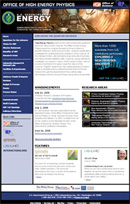DOE Office of High Energy Physics launches new site
 |
| The new DOE Office of High Energy Physics Web site. |
The drive to understand the world around us is a basic part of our humanity, says the new P5 report. Research in fundamental science provides the ideas and discoveries that form the long-term foundation for science and technology, which in turn. drive the global economy, our very way of life and a newly launched Department of Energy Web site.
The new DOE Office of High Energy Physics Web site provides insight into how particle physics benefits society, plus in-depth information about the nation's current research program and a vision for future plans.
"Particle physics has a compelling story to tell," said Glen Crawford, director of the Research and Technology R&D Division in the Office of High Energy Physics. "From the congressional staffer learning about particle physics to the budget officer investigating a grant proposal, we hope that the new site will serve as a useful resource and tell the story well."
The new site defines the questions that drive particle physics and the current and upcoming experiments that will provide answers. It also describes the five research areas that make up the U.S. particle-physics program: proton accelerator-based physics, electron accelerator-based physics, non-accelerator physics, theoretical physics and advanced technology R&D.
The benefits section highlights how particle physics has contributed to areas such as medicine, homeland security, industry, computing and workforce development. A fact sheet that summarizes select examples of these applications is also available to download.
The new site includes an up-to-date list of the DOE HEP grant programs, project status and a summary of the budget process.
-- Elizabeth Clements
|